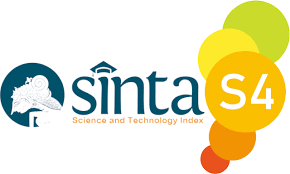Profitability Ratio Analysis of the Leather Tanning Industry With Loan Capital Structure Interest System
Abstract
The leather tannery industry in Sukanggang Garut declined in number due to bankruptcy, which was caused by declining business profitability. The profitability of tanned leather craftsmen was initially 6.5 million rupiah to 2.3 million rupiah per ton of raw materials. The decline in the level of profitability was due to changes in the capital structure, with many using loan capital with an interest system compared to own capital. The purpose of this study was to determine the effect of interest system loans on the profitability of the leather industry. This study uses the method of profitability ratio analysis. From the research results, the ratio of GPM, NPM and ROI decreased along with the increase in the number of loans with an interest system. GPM continued to decline from 39.02 percent to 35.37 percent. NPM continued to decline from 15.26 percent to 8.26 percent. ROI decreased from 18.00 percent to 8.05 percent. ROE actually increases with the increase in the number of loans in its capital structure.
References
Caballero SB, Teruel PJG, Solano PM. 2012. How does working capital management affect the profitability of Spanish SMEs? Small business economics, 39(2) : 517-529
Hamid, Masdiah A, Azizah A, Nur AK. 2015. “Capital Structure and Profitability in Family and Non-Family Firms: Malaysian Evidence.” Procedia Economics and Finance 31 (15). Elsevier B.V.: 44–55. doi:10.1016/S2212-5671(15)01130-2
Kurniawan A, Sukardi, Indrasti NS, Suparno O. 2020. Profitability analysis of leather tanning industry with capital structure without interest using canvas financial management approach. IOP Conf. Series: Earth and Environmental Science 472 (2020) 012061.
Mohammadzadeh M, Farimah R, Forough R, Aarabi SM, Salamzadeh J. 2013. The effect of capital structure on the profitability of pharmaceutical companies the case of Iran. Iranian journal of pharmaceutical research 12 (3): 573-577
Negasa T. 2016. “The Effect of Capital Structure on Firms Profitability (Evidenced from Ethiopian).” Preprints, no. July. doi:10.20944/preprints201607.0013.v1.
Pramesti H, Satyawati E. 2007. Analisis pengaruh biaya bunga pinjaman terhadap laba bersih periode sebelum krisis dan selama krisis pada perusahaan real estate dan property di bursa efek Jakarta. Jurnal bisnis dan ekonomi. 14(1): 105-125.
Purwanti E, Wibowo MA. 2018. Analisis rasio keuangan untuk memprediksi kebangkrutan perusahaan rokok. Among makarti Vol.11 (21); 1-16
Rahimian dan Meysam. 2016. “The Relationship between Capital Structure and Profitability of Companies Listed in Tehran Stock Exchange.” European Online Journal of Natural and Social Sciences 5 (1): 128–31.
Saragih F. 2017. Analisis rasio profitabilitas dalam menilai kinerja keuangan perusahaan pada pt. pelabuhan indonesia I (persero) Medan. Ekonomikawan. 57-68
Singh, Gurmeet. 2013. “Interrelationship between Capital Structure and Profitability with Special Reference to Manufacturing Industry in India.” International Journal of Management and Social Sciences Research
Syafri H, Sofyan. 2008. Analisa Kritis atas Laporan Keuangan, PT. Raja Grafindo Persada, Jakarta.
Yulia A, Mayasari. 2008. Studi Kasus Pengaruh Struktur Modal Terhadap Profitabilitas Perusahaan Po. Gagak Rimang Periode Tahun 2000-2007. Jurnal Strategic. 7(13):10-19.











